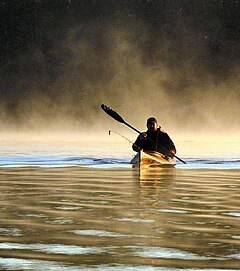Kayak fishing
History
- Kayaks (Inuktitut: qajaq, Inuktitut syllabics: ᖃᔭᖅ) were originally developed by indigenous people living in the Arctic regions, who used the boats to hunt on inland lakes, rivers and the coastal waters of the Arctic Ocean, North Atlantic, Bering Sea and North Pacific oceans. These first kayaks were constructed from stitched animal skins such as seal stretched over a wooden frame made from collected driftwood, as many of the areas of their construction were treeless. Archaeologists have found evidence indicating that kayaks are at least 4000 years old.[1] The oldest still existing kayaks are exhibited in the North America department of the State Museum of Ethnology in Munich.[citation needed]
[edit] Modern fishing kayaks
- While native people of the Arctic regions did not rely on kayaks for fishing, in recent years sport fishing from kayaks has become popular in both fresh and salt water, especially in warmer regions due to the ease of entry. Kayaks can be purchased inexpensively and have little maintenance cost. Kayaks can be stored in small spaces and launched quickly. Many kayak anglers have started customizing their kayaks for fishing.[2]
The most popular kayaks for fishing are rotationally molded from polyethylene due to their durability and lower cost. Generally, kayak fishermen look for stable and comfortable designs. The new generation of twinhull (catamaran) kayaks that was recently introduced into the market is stable enough to enable both paddling and fishing in the standing position. This technological development also solves some ergonomic problems that are associated with sitting for long hours without being able to change positions, and frees kayakers from the need to sacrifice speed to stability, which is another problem that characterizes monohull kayaks.
There are also kayaks propelled by flippers or propellers and a foot mechanism. These kayaks offer hands free fishing and all the benefits associated.
Kayak Fishing has taken off dramatically in South Africa. Game fish are caught along the coastline North and South of Durban. Large fish such as Marlin and Sailfish can be caught.
[edit] Fishing techniques
Contemporary kayaks can be equipped with after-market fishing accessories such as anchor trolleys, rod holders, electronic fish-finders and live-bait containers. Kayak anglers target highly-prized gamefish like snook, red drum, seatrout, tarpon, halibut and cod and also pelagics like amberjacks, tuna, sailfish, wahoo, king mackerel, and even marlin.
While bottom fishing or jigging can be done from small boats, it was long thought that effective trolling required speeds of five to ten knots, a speed well out of the range of someone paddling. However, the discovery that fish could be taken at much lesser speeds has increased the popularity of kayak fishing.[3]
Some anglers launch kayaks from larger boats well offshore so they can play game fish from the kayak. They find much excitement fighting a game fish as it pulls the kayak through the water.[citation needed]
Recently kayak fishing has started to move inland to freshwater lakes and rivers, where anglers target gamefish like largemouth bass, smallmouth bass, trout, muskellunge, and salmon.
Some of the biggest benefits of kayak fishing are in the ease of use and transportation, the affordability of the equipment compared to boats, they're an eco-friendly watercraft, and they provide both form, function, and fun.
Source: http://en.wikipedia.org/
More Stories: http://gofishtalk.com/forum/topics/kayak-fishing



No comments:
Post a Comment